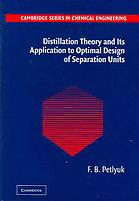Table Of ContentP1:FCH/FFX P2:FCH/FFX QC:FCH/FFX T1:FCH
CB644-FM CB644-Petlyuk-v1 June15,2004 4:28
This page intentionally left blank
ii
P1:FCH/FFX P2:FCH/FFX QC:FCH/FFX T1:FCH
CB644-FM CB644-Petlyuk-v1 June15,2004 4:28
Distillation Theory and Its Application to Optimal Design
of Separation Units
Distillation Theory and Its Application to Optimal Design of Separation Units
presentsaclear,multidimensional,geometricrepresentationofdistillationtheory
that is valid for all types of distillation columns for all splits, column types, and
mixtures.Thisrepresentationanswerssuchfundamentalquestionsas:
(cid:1)
Whatarethefeasibleseparationproductsforagivenmixture?
(cid:1)
Whatminimumpowerisrequiredtoseparateagivenmixture?
(cid:1)
Whatminimumnumberoftraysisnecessarytoseparateagivenmixtureat
afixed-powerinput?
Methodsofthegeneralgeometrictheoryofdistillation,encodedinsoftware,
provide quick and reliable solutions to problems of flowsheet synthesis and to
optimaldesigncalculations.DistillDesignersoftwareallowsrefinementandcon-
firmationofthealgorithmsofoptimaldesign.Asampleofthissoftwareisavailable
atwww.petlyuk.com.
Thisbookisintendedforstudentsandspecialistsinthedesignandoperation
ofseparationunitsinthechemical,pharmaceutical,food,wood,petrochemical,
oil-refining,andnaturalgasindustries,andforsoftwaredesigners.
FelixB.Petlyuk,Ph.D.,D.Sc.,hasworkedinthepetrochemicalengineeringandoil-
refiningindustriesformorethan40years.Hecurrentlyworksfortheengineering
firmECTServiceinMoscow.
i
P1:FCH/FFX P2:FCH/FFX QC:FCH/FFX T1:FCH
CB644-FM CB644-Petlyuk-v1 June15,2004 4:28
ii
P1:FCH/FFX P2:FCH/FFX QC:FCH/FFX T1:FCH
CB644-FM CB644-Petlyuk-v1 June15,2004 4:28
CAMBRIDGE SERIES IN CHEMICAL ENGINEERING
SeriesEditor:
ArvindVarma,PurdueUniversity
EditorialBoard:
AlexisT.Bell,UniversityofCalifornia,Berkeley
JohnBridgwater,UniversityofCambridge
EdwardCussler,UniversityofMinnesota
L.GaryLeal,UniversityofCalifornia,SantaBarbara
MassimoMorbidelli,ETH,Zurich
StanleyI.Sandler,UniversityofDelaware
MichaelL.Shuler,CornellUniversity
BooksintheSeries:
E.L.Cussler,Diffusion:MassTransferinFluidSystems,SecondEdition
Liang-ShihFanandChaoZhu,PrinciplesofGas-SolidFlows
HasanOrbeyandStanleyI.Sandler,ModelingVapor-LiquidEquilibria:Cubic
EquationsofStateandTheirMixingRules
T.MichaelDuncanandJeffreyA.Reimer,ChemicalEngineeringDesign
andAnalysis:AnIntroduction
JohnC.Slattery,AdvancedTransportPhenomena
A.Varma,M.Morbidelli,andH.Wu,ParametricSensitivityinChemicalSystems
M.Morbidelli,A.Gavriilidis,andA.Varma,CatalystDesign:OptimalDistribution
ofCatalystinPellets,Reactors,andMembranes
E.L.CusslerandG.D.Moggridge,ChemicalProductDesign
PaoC.Chau,ProcessControl:AFirstCoursewithMATLAB®
RichardNobleandPatriciaTerry,PrinciplesofChemicalSeparationswith
EnvironmentalApplications
RodneyFox,ComputationalModelsforTurbulentReactingFlows
iii
P1:FCH/FFX P2:FCH/FFX QC:FCH/FFX T1:FCH
CB644-FM CB644-Petlyuk-v1 June15,2004 4:28
iv
P1:FCH/FFX P2:FCH/FFX QC:FCH/FFX T1:FCH
CB644-FM CB644-Petlyuk-v1 June15,2004 4:28
Distillation Theory and Its
Application to Optimal Design
of Separation Units
F. B. Petlyuk
v
Cambridge, New York, Melbourne, Madrid, Cape Town, Singapore, São Paulo
Cambridge University Press
The Edinburgh Building, Cambridge , UK
Published in the United States of America by Cambridge University Press, New York
www.cambridge.org
Information on this title: www.cambridge.org/9780521820929
© F. B. Petlyuk 2004
This publication is in copyright. Subject to statutory exception and to the provision of
relevant collective licensing agreements, no reproduction of any part may take place
without the written permission of Cambridge University Press.
First published in print format 2004
- ----
eBook
- ---
eBook
- ----
hardback
- ---
hardback
Cambridge University Press has no responsibility for the persistence or accuracy of s
for external or third-party internet websites referred to in this publication, and does not
guarantee that any content on such websites is, or will remain, accurate or appropriate.
P1:FCH/FFX P2:FCH/FFX QC:FCH/FFX T1:FCH
CB644-FM CB644-Petlyuk-v1 June15,2004 4:28
Contents
Preface page xiii
Acknowledgments xvii
Nomenclature xix
1. Phase Equilibrium and Its Geometric Presentation 1
1.1 Introduction 1
1.2 ConcentrationSpace 1
1.3 PhaseEquilibriumofBinaryMixtures 3
1.4 PhaseDiagramsofThree-ComponentMixtures 5
1.5 ResidueCurveBundlesofFour-ComponentMixtures 8
1.6 MatrixDescriptionoftheMulticomponentMixtureResidue
CurveStructure 10
1.7 Lines,Surfaces,andHypersurfaces K =K 12
i j
1.8 Liquid–Liquid–VaporPhaseDiagrams 15
1.9 Conclusion 17
1.10 Questions 18
1.11 ExerciseswithSoftware 18
References 18
2. Basic Concepts of Distillation 20
2.1 PurposeandProcessEssenceofDistillation 20
2.1.1. DescriptionofDistillationProcess 21
2.1.2. SystemofAlgebraicEquationsofDistillation 22
2.2 GeometricInterpretationofBinaryDistillation:Refluxandthe
NumberofTrays 23
2.2.1. McCabe-ThieleDiagram 23
2.2.2. InfluencesofNonideality 24
2.3 GeometricInterpretationofMulticomponentMixture
Distillation:Splits 25
2.4 TrajectoryBundlesUnderInfiniteReflux:DistillationDiagrams 26
2.5 TrajectoryBundlesUnderFiniteReflux 27
2.6 MinimumRefluxMode:FractionationClasses 29
2.6.1. BinaryDistillation 29
2.6.2. DistillationofThree-ComponentMixtures 31
vii
P1:FCH/FFX P2:FCH/FFX QC:FCH/FFX T1:FCH
CB644-FM CB644-Petlyuk-v1 June15,2004 4:28
viii Contents
2.7 Adiabatic,Nonadiabatic,andReversibleDistillation 32
2.8 SeparationofAzeotropicMixturesbyDistillationUnderTwo
PressuresorHeteroazeotropicandExtractiveDistillation 35
2.9 IsProcessOppositetoDistillationProcessPossible? 36
2.10 MixtureswithLimitedandUnlimitedSeparability 37
2.11 TheProblemofDesigningDistillationUnits 38
2.12 Questions 38
References 39
3. Trajectories of Distillation in Infinite Columns Under Infinite Reflux 40
3.1 Introduction 40
3.2 AnalogyBetweenResidueCurvesandDistillationTrajectories
UnderInfiniteReflux 41
3.3 DistillationTrajectoriesofFiniteandInfiniteColumnsatSet
FeedComposition 43
3.3.1. DimensionalityofProductCompositionRegionsforFinite
andInfiniteColumns 43
3.3.2. ProductCompositionRegionsforIdealThree-Component
Mixtures 44
3.3.3. ProductCompositionRegionsforIdealFour-Component
Mixtures 45
3.3.4. FeasibleSplitsforIdealMixtures 47
3.3.5. ProductCompositionRegionsforAzeotropic
Three-ComponentMixtures 48
3.4 RulefortheCheckupofAzeotropicMixturesSeparabilityat
R=∞andN=∞ 52
3.4.1. DistillationTrajectoriesLocationatR=∞andN=∞ 52
3.4.2. ApplicationoftheRuleofConnectedness 53
3.4.3. n-ComponentMixture 55
3.5 FeasibleSplitsatR=∞andN=∞ 57
3.5.1. MethodofProductSimplexforDistillationSubregions
(m=n)5 9
3.5.2. MethodofProductSimplexforDistillationSubregions
(m>n)6 1
3.5.3. AlgorithmofProductSimplexforn-ComponentMixtures 63
3.6 SeparationofAzeotropicMixturesinSequenceofColumnswith
RecyclesatR=∞andN=∞ 71
3.7 NonsingularityofSeparationProductsCompositionsatR=∞
andN=∞ 72
3.8 Conclusion 73
3.9 Questions 74
3.10 ExerciseswithSoftware 74
References 75
4. Trajectories of Thermodynamically Reversible Distillation 77
4.1 Introduction 77
4.2 EssenceofReversibleDistillationProcessandItsPeculiarities 78
4.2.1. EssenceofReversibleDistillationProcess 78
4.2.2. LocationofReversibleDistillationTrajectories 79
4.2.3. SharpandNonsharpReversibleDistillationofIdeal
Mixtures 80

